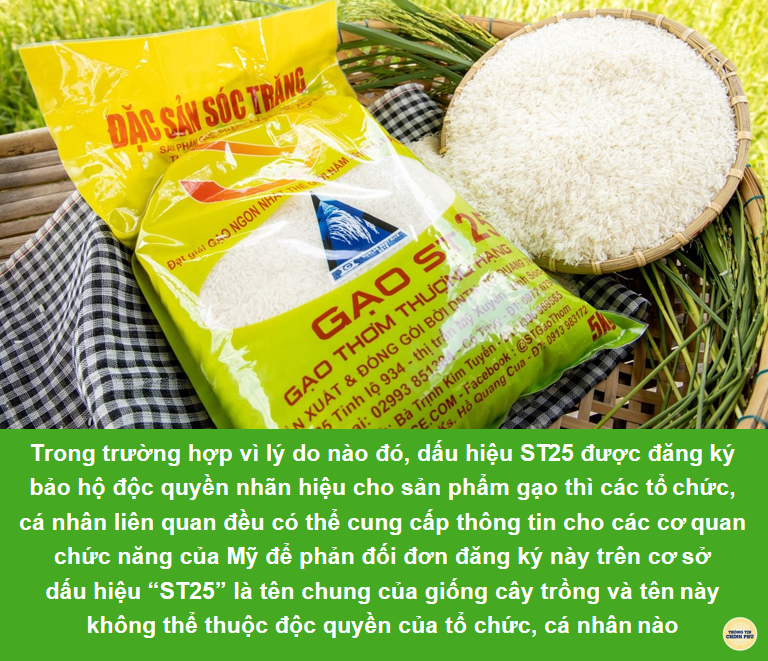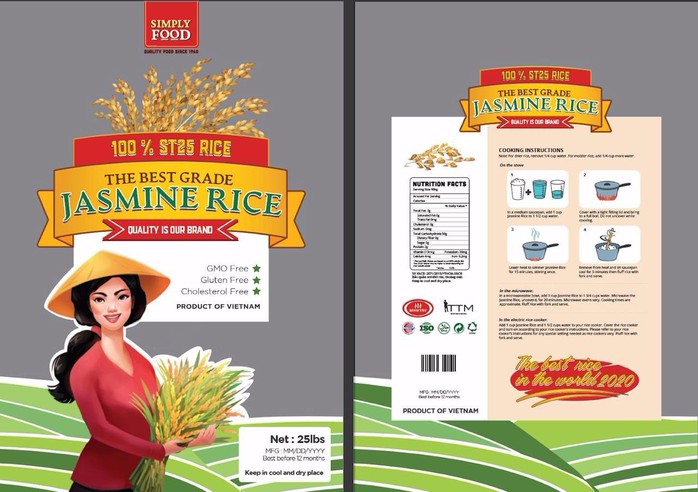[Không ai có thể đăng ký độc quyền nhãn hiệu gạo ST25]

Executive Summary

This article addresses the misconception that any single entity can claim exclusive trademark rights over the renowned ST25 rice variety. We will delve into the legal complexities surrounding geographical indications, trademark law, and the collective ownership inherent in agricultural products like ST25. This exploration aims to clarify the situation for farmers, businesses, and consumers alike, dispelling the myth of sole ownership and highlighting the importance of protecting the collective interest in this valuable rice brand. The information provided is intended for informational purposes and does not constitute legal advice.

Introduction
The exceptional quality of ST25 rice has garnered global recognition, leading to attempts by various parties to claim exclusive rights over its brand. However, the nature of agricultural products and the principles of intellectual property law complicate this claim. This article seeks to unpack the legal and practical realities behind the ownership and branding of ST25 rice, emphasizing the shared heritage and collaborative effort required for its continued success. The goal is to provide a comprehensive understanding of the situation and prevent further misunderstandings.
Frequently Asked Questions (FAQ)
Q: Can someone own the trademark for ST25 rice entirely?
A: No. While individuals or companies can register trademarks for specific brands of ST25 rice, no single entity can claim exclusive rights to the name “ST25” itself. The designation is intrinsically linked to the rice variety’s origin and characteristics, making it subject to different legal frameworks than a purely invented brand name.
Q: What legal protections exist for ST25 rice?
A: The most relevant protection comes from Geographical Indications (GIs). GIs protect the name and reputation of products linked to a specific geographical area, ensuring quality and authenticity. While ST25’s GI status might not be fully established everywhere, it’s crucial for upholding the integrity of the product. Individual businesses can also trademark their specific brands using ST25 as a descriptive element, but not exclusively.
Q: What happens if someone tries to falsely represent their rice as ST25?
A: This constitutes unfair competition and trademark infringement, actionable under relevant laws. However, the challenge lies in proving deliberate misrepresentation and establishing the extent of damage. Collective action by farmers and organizations representing the ST25 rice producers is crucial in combating such fraudulent practices.
The Importance of Geographical Indications (GIs) for ST25
Geographical Indications (GIs) are crucial for safeguarding the reputation and quality of ST25 rice. GIs link a product’s quality and characteristics to its geographical origin. This protection prevents others from using the name or reputation of ST25 to sell inferior rice.
- Authenticity: GIs guarantee the authenticity of ST25 rice, ensuring consumers receive the genuine product known for its unique taste and aroma.
- Quality Control: GIs often involve standards and regulations to maintain the consistent quality of ST25 rice produced within the designated region.
- Economic Benefits: GIs provide economic benefits to farmers and producers by adding value to their products and enhancing their market competitiveness.
- Brand Protection: While not providing complete ownership, GIs contribute significantly to the overall brand protection of ST25 rice.
- Consumer Confidence: GIs build consumer confidence, assuring buyers of the product’s quality and origin.
- Legal Framework: GIs offer a legal framework for addressing instances of mislabeling or unfair competition involving ST25 rice.
Trademark Law and its Limitations in the Case of ST25
Trademark law plays a role in protecting specific brands of ST25 rice but cannot grant exclusive rights to the name itself. Companies can register trademarks for their individual brands that utilize “ST25” as a descriptive element, but they cannot prevent others from using “ST25” to describe their own products of the same variety, provided they do not infringe on existing trademarks.
- Brand Differentiation: Companies can use trademarks to differentiate their brands of ST25 rice from competitors. This helps consumers identify preferred products within the wider market.
- Brand Recognition: Trademark registration enhances brand recognition and builds customer loyalty.
- Legal Protection: Trademarks offer legal protection against infringement, preventing others from using identical or confusingly similar marks.
- Limited Scope: Trademarks cannot claim exclusive rights over the name “ST25” as a generic term for the rice variety itself.
- Collective vs. Individual: This underscores the crucial distinction between collective rights (tied to the rice variety’s origin) and individual rights (tied to specific brands).
The Collective Ownership of ST25 Rice
The essence of ST25 rice is fundamentally linked to the collective efforts of farmers, researchers, and local communities in its region of origin. No single entity can claim sole ownership of this shared heritage. Recognizing this collective ownership is crucial for the sustainable development and protection of ST25 rice.
- Shared Heritage: ST25’s success reflects the collective contributions of many, including generations of farmers who have cultivated and perfected the variety.
- Community Involvement: Active community participation is vital for maintaining the quality and reputation of ST25 rice.
- Fair Practices: Collective ownership promotes fair practices within the ST25 rice production chain, ensuring equitable distribution of benefits.
- Sustainable Development: Protecting collective ownership ensures the sustainability of ST25 rice production for generations to come.
- Economic Empowerment: This approach empowers local communities and encourages economic development within the region.
The Role of Farmers and Producer Organizations in Protecting ST25
Farmers and producer organizations play a critical role in protecting ST25 rice. Their collective efforts are crucial in maintaining the quality, safeguarding the reputation, and ensuring the sustainability of this valuable rice variety.
- Quality Standards: Farmers’ organizations can establish and enforce quality standards for ST25 rice, ensuring consistent quality and meeting consumer expectations.
- Collective Branding: Collaborative branding strategies can effectively promote ST25 rice and protect its reputation in the marketplace.
- Market Access: Producer organizations can facilitate market access for ST25 rice, ensuring fair prices for farmers and increased market share.
- Legal Action: Collective action through producer organizations can be crucial in combating unfair competition and counterfeit products.
- Knowledge Sharing: Facilitating knowledge sharing among farmers contributes to continuous improvement in the cultivation and production of ST25 rice.
Combating Misinformation and Protecting the ST25 Brand
Combating misleading information about the ownership of ST25 rice is crucial for its future. Clear and consistent communication about the collective nature of its ownership, coupled with active protection of GIs and trademarks where applicable, can prevent misunderstandings and protect the interests of all stakeholders.
- Transparency: Openly communicating the facts about ST25 ownership and the legal protections in place is essential for fostering trust among stakeholders.
- Public Awareness: Raising public awareness about the value of ST25 rice and its unique characteristics is crucial for building demand and combating misinformation.
- Collaboration: Collaborative efforts between farmers, producers, researchers, and government agencies are essential for addressing any challenges effectively.
- Legal Enforcement: Taking decisive action against fraudulent activities or misleading claims is crucial for upholding the integrity of ST25 rice.
- International Cooperation: Collaborating with international organizations and governments to protect ST25 rice’s unique identity and market position is a critical step.
Conclusion
The notion that any single entity can exclusively own the trademark for ST25 rice is a misconception. The reality is far more nuanced, encompassing geographical indications, trademark law, and, most importantly, the collective ownership inherent in the rice variety’s history and production. While individual brands utilizing the ST25 name can be trademarked, the name itself remains tied to the collective efforts of numerous farmers, researchers, and communities. Protecting ST25 requires a collaborative approach focusing on upholding geographical indications, enforcing trademark rights where appropriate, and actively combating misinformation. Only through a unified and transparent approach can the exceptional reputation and economic value of ST25 rice be preserved and enhanced for the benefit of all.
Keyword Tags
ST25 rice, Geographical Indications (GIs), Trademark Law, Collective Ownership, Brand Protection
